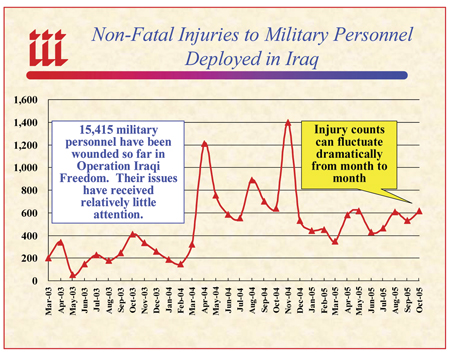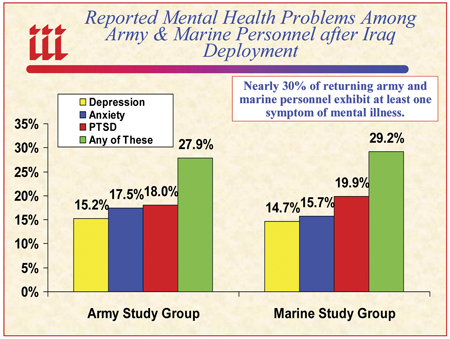|
|
WHEN JOHNNY COMES MARCHING HOMEInjured Veterans Returning from War Present Unique Challenges for Insurers Robert
P. Hartwig, Ph.D., CPCU, By the time “major operations” are complete in Afghanistan and Iraq, more than two million United States military personnel will have been deployed in those theaters, many more than once. Approximately 30 percent of those serving are citizen soldiers—National Guard and Reservists—plucked from their jobs and families in cities and towns across America for tours of duty lasting a year or more. The Pentagon is planning for troop strength levels of at least 100,000 through 2009 in Iraq, and the Bush Administration has been wary of providing any timetable for a drawdown of troop strength levels. The extended timeline for U.S. operations in Iraq and Afghanistan means large numbers of National Guard members and Reservists are currently reentering the labor force and will continue to do so for the next several years. Over time they will be joined by hundreds of thousands of active duty personnel seeking civilian employment after their separation from military service. These men and women have fought bravely for their country, but the brutal nature of war exacts a steep physical and psychological toll on those called upon to wage it. Most have endured significant physical, emotional and psychological hardships. More than 2,000 have died and well over 15,000 have been injured in Iraq alone. Each death is tragic and the mounting cost in lives is a divisive issue that is currently the subject of intense political debates that are well beyond the scope of this article. Relevant from an insurance perspective, however, and a workers compensation perspective in particular, are the much less discussed challenges that tens of thousands of physically injured service men and women and their employers will face when they rejoin the civilian workforce. Hundreds of thousands of others will carry the psychological wounds of their experience with them for many years after their tour of duty ends. While the vast majority of military personnel will enjoy a relatively seamless reentry to civilian life and employment, following a pattern established by veterans of past conflicts, reintegration of the physically and psychologically injured will likely present unexpected challenges to a generation of employers with no experience in dealing with such large numbers of returning veterans.
Figure 1 shows that large numbers of military personnel are physically wounded each month in Iraq. From the beginning of Operation Iraqi Freedom in March 2003 through October 31, 2005, a total of 15,415 military personnel had been physically wounded in action, an average of 482 per month.1 In the opening months of the war through March 2003, there were 236 wounded per month on average. But as the insurgency within Iraq gained strength, the number of wounded increased sharply, averaging 650 per month since April 2004.
Fig.
1 Non-Fatal Injuries to Military Personnel Deployed in Iraq
The actual number of military personnel injured in Iraq is much higher than official Pentagon figures suggest because the military releases figures only for those wounded in “hostile incidents.” There are no doubt many thousands of injuries sustained by troops in non-hostile incidents such as motor vehicle accidents, and soft tissue injuries sustained while performing demanding physical tasks under harsh conditions. Indeed, 22 percent of military deaths in Iraq through October 2005 were the result of injuries sustained in non-hostile situations. Additionally, thousands of civilian contractors working in Iraq have also been injured and are eligible for compensation under the provisions of the Defense Base Act.
The issue of reintegrating veterans back into the social and economic fabric of America is not new. After World War II, the “GI Bill” provided educational benefits to returning service men and women. Other government programs provided assistance with employment, home mortgages and health care. These programs were immensely successful, contributing to a sustained period of extraordinary economic growth and innovation driven by what has become known as this country’s “Greatest Generation.” But hundreds of thousands of physically injured veterans faced special challenges and even discrimination in the workplace because of their disability. Though they had put their lives on the line for their country, shed blood and even sacrificed parts of their body on the battle field, employers—fixated on profits and productivity in the post-war economic boom and unfettered by modern day anti-discrimination laws such as the Americans with Disabilities Act—were understandably concerned that injuries sustained during the war would recur or be aggravated, impairing the worker’s ability to perform, or even work at all. Not only would productivity suffer, but workers compensation costs would be driven up due to injuries originally sustained during military service. To accommodate these concerns, many states established “second injury funds” (SIFs). SIFs allowed employers (and their insurers) to cede costs of injuries that were principally the result of a worker’s prior injury to a statewide plan that would redistribute those losses across all employers (insurers) in the state. Effectively, SIFs functioned as reinsurers of second injury claims. The number of second injury funds has declined in recent years, with states reasoning that they are no longer needed since the enactment of the Americans with Disability Act in 1990, which not only prohibits discrimination against disabled employees but also requires employers to make reasonable accommodations for them in the workplace.
Employers and their insurers need to be prepared for the tens of thousands of physically injured veterans returning from conflicts in Iraq and Afghanistan. Workplace injuries that are primarily the result of injuries originally sustained during military service will generally be covered by the employer’s workers compensation program or, in some states, a second injury fund. In certain states, workers compensation benefits may be apportioned or partially offset by other disability payments received. Veterans are also entitled to lifetime medical benefits from the Veterans Administration for service-related injuries. In addition, employers will need to adhere to the law pursuant to the Americans with Disabilities Act (ADA). The ADA prohibits discrimination and ensures equal opportunity for persons with disabilities in employment, state and local government services, public accommodations, commercial facilities and transportation. In other words, discrimination based on physical handicap is not permitted in the hiring or promotion process, and reasonable accommodations must be made to meet the needs of disabled workers. Failure to comply with the terms of the ADA could result in legal action and fines by the Equal Opportunity Employment Commission. Since 1992, the EEOC has awarded $529 million to people found to have been discriminated against in violation of the ADA. Employers could also be subject to tort actions under their Employment Practices Liability coverage or Directors’ and Officers’ policies.
Workers compensation systems and second injury funds were established to help workers suffering from physical injuries. In recent years many states have broadened the definition of compensable occupational illness and disease to encompass stress and mental health disorders. According to a 2004 study in the New England Journal of Medicine, nearly 30 percent of Army and Marine personnel returning from Iraq suffered from at least one type of mental health problem (see Figure 2), including depression, anxiety and/or post-traumatic stress disorder (PTSD).
Fig.
2 Reported Mental Health Problems Among Army &
Troops exhibiting symptoms of mental health problems are usually loathe to admit it and are unlikely to seek professional help, meaning that such problems could continue to manifest themselves after separation from military service. Consider the following findings from the NEJM study for military personnel serving in Iraq who had already met screening criteria for major depression, anxiety or PTSD:
Military personnel cited a variety of reasons for not seeking help, including their belief they would be perceived as weak (65 percent), difficulty getting time off for treatment (55 percent) and embarrassment (41 percent). Moreover, 38 percent indicated that they did not trust mental health professionals, while 25 percent believed mental health care doesn’t work. The vast majority of returning veterans will readjust to civilian life and rejoin the workforce with no difficulty. However, employers must also be alert to signs of possible mental health issues. Monitoring is probably wise for a period of time, especially if the returning worker’s job is stressful, involves the operation of heavy machinery or equipment and/or driving. Few employers or insurance claims staffs, however, are trained to recognize the telltale signs of mental illness. Employers and their insurers should be aware that veterans who were wounded or suffer from a service-related mental illness are also entitled to lifetime benefits from the Veterans Administration. The VA also operates a Readjustment and Counseling Service (www.va.gov/rcs) to ease the transition of veterans returning to civilian life.
Support of American troops serving in Iraq and Afghanistan does not end with their separation from military service. In many respects, our support as a nation begins anew, with equal access to jobs, education and health care. Because economic opportunity is so critical to the successful reintegration of veterans, the role of employers is crucial. Consequently, a variety of programs and legislation exist that impact the employer’s relationship with returning veterans, especially those who have been physically or psychologically injured in service to their country. By simply treating our returning service personnel with the respect they deserve, veterans’ needs will be met while employers benefit from experienced, highly productive workers who have proven and distinguished themselves through their service to their country. 1. Most wounded are returned to action. 2. Some military personnel may be wounded more than once.
© 2015 TLC Magazine Online, Inc. |

